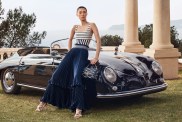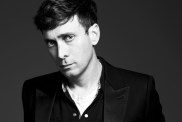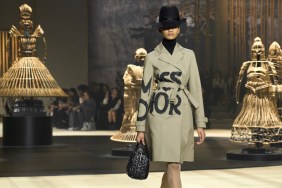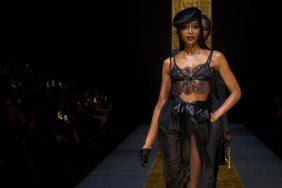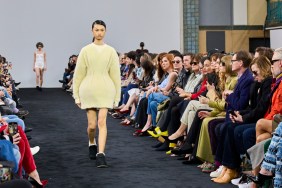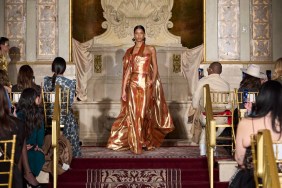Ahead of the Spring 2017 shows, players at all tiers of the fashion pyramid called out for change. The Council of Fashion Designers of America (CFDA) — the veritable governing body of fashion — issued a set of “racial diversity pointers” in an effort to “encourage the industry to be inclusive of racial diversity when preparing casting of models for their company needs.”
Elsewhere, supermodel/icon Naomi Campbell sat down with The New York Times on the eve of New York Fashion Week’s kickoff. “I’m very optimistic about diversity because I know I’m never going to shut up about it until the girls get better,” she said, continuing, “It’s getting better, I think. I think this is going to be a good season. It’s just a feeling. There’s no count yet. But I feel it’s going to be a good season. I think things have to evolve and I think that it’s different things for different folks.”
Embodying the words of the legendary supermodel are two women — two working models — who don’t fit into Campbell’s statuesque, willowy mold. Clémentine Desseaux and Charli Howard had to leave their home cities of Paris and London, respectively, in order to find a place for themselves in an industry that doesn’t readily accept women of different body types. In founding the All Woman Project, the pair sought to highlight the idea that no two women are the same and illustrate the beauty of diversity. The project’s first campaign launched precisely one week before New York Fashion Week “because September is like the least diverse month of the year,” Desseaux told Mic. “So it’s to show that diversity is important and that it shouldn’t be forgotten.”
Many style bloggers, among them theCURVYcon co-founder CeCe Olisa, live by this “be the change you want to see in the fashion world” mantra. “I see the industry making an effort toward diversity, but there is so much room for improvement and inclusion,” Olisa told theFashionSpot. “It is so powerful to see women who look like you reflected in mainstream media and we need more of that. The Internet gives us the power to create the diversity we want to see.”
With so many key players vocalizing the need for inclusion, we were curious to see whether the presence of these top-down pressures would translate to a change in the runway diversity numbers. Here’s what we found.
RACE

The finale at Tome’s Spring 2017 presentation; Image: Imaxtree
For the Spring 2017 season, we examined 299 shows and 8,832 model appearances from New York, London, Paris and Milan. For the first time in recent history, more than 25 percent of the model castings were nonwhite. Across the Spring 2017 runways, 74.6 percent of the models cast were white and 25.4 percent were women of color. Although this figure is far from where it needs to be, it is slightly better than the 75.3 percent we reported for Fall 2016 and the 77.6 percent from the previous spring.

click to view full infographic
Season over season, Black, Middle Eastern and Latina models all saw a minor bump in castings. Asian models, however, appeared with slightly less frequency, dropping from 7.48 percent for Fall 2016 to 7 percent for Spring 2017.
Of the four major fashion capitals, New York had the highest diversity rating by far (30.3 percent models of color), notwithstanding a slight dip in the percentage of models of color cast from Fall 2016 (31.9 percent) to Spring 2017. Paris came in a distant second (24.1 percent models of color), trailed closely by London (23.5 percent models of color). In Milan, which consistently falls at the bottom of the pile, only 20.9 percent models of color walked the runways.
This marks the first time since we began crunching the numbers in October 2014 that New York’s upward trend toward racial inclusion has stumbled. (An especially puzzling development, given the CFDA’s explicit call for change.)

click to view full infographic
Still, it is encouraging that Milan and Paris have now seen steady improvements season over season since Spring 2015. Even more so that London, which was less diverse for the Fall 2016 season (with 19.9 percent models of color) than prior seasons, saw a 3.6 percent increase in the number of nonwhite model castings for Spring 2017 — the most significant jump of any city. London’s move toward inclusion on the runways is especially poignant given the rise in racially motivated hate crimes in the capital following Great Britain’s recent decision to leave the European Union.
The poster child for British fashion designers’ (slightly) increased cultural awareness is undoubtedly Ashish Gupta, whose semi-eponymous label is known for its intricately embroidered and sequined pieces. Of the shows that led the way in terms of inclusion, Ashish was the only one that took place outside of New York. In the third most diverse show of the season (75 percent of models were nonwhite), the Delhi-born designer celebrated his native “Indian culture, because it is also such an integral part of British culture,” sending models down the runway in saris and sportswear alike.

London’s Ashish Spring 2017 presentation was the third most diverse of the season; Image: Imaxtree
For the second season in a row, Kanye West earned top marks for inclusion. The ever-controversial master of spectacle sent 97 percent models of color down the Yeezy Season 4 runway, a slight decline from his entirely nonwhite Yeezy Season 3 show. Two years after launching her namesake label, Kimora Lee Simmons took home the proverbial silver medal with an 82 percent diversity score. Brandon Maxwell had the fourth most multicultural show of Fashion Month. Of the 32 models cast by the Lady Gaga favorite, 22 were nonwhite, which equates to a 69 percent diversity rating, up from 53 percent in Fall 2016. (Campbell, who sat front row, gave the collection a standing ovation.) At Chromat, a longtime champion of diversity, 65 percent of models were nonwhite, down from 85 percent the prior season. (Before you despair, we should note that the club/swimwear designer’s catwalk was stunningly diverse in other respects, but more on that later.) Not far behind was Rebecca Minkoff, who cast 62 percent models of color, a 12 percent jump from last season’s score. Rounding out the list of notables is Telfar, maker of androgynous basics in all shades of nude, which unsurprisingly sent 67 percent models of color down its Spring 2017 runway.

click to view full infographic
Despite the ongoing efforts to raise awareness about the inequality in the industry, many brands still won’t get with the program. Of the 67 models who walked for industry darling Alessandro Michele, only five were nonwhite, which equates to a far from “Gucci” 7 percent diversity score. Meanwhile, Zimmermann, Olivier Theyskens, Jasper Conran, Marques ‘ Almeida, Erdem and Genny cast just two models of color or fewer, resulting in runways that were 5 percent diverse — at most. And that wasn’t even the worst of it.
Mila Schön, Daniela Gregis, Anrealage and Junya Watanabe presented entirely whitewashed lineups, Watanabe for the third season in a row. And speaking of rows, Mary-Kate and Ashley Olsen’s much-lauded womenswear and accessories label The Row completely shunned models of color — again.

click to view full infographic
Given these findings, it’s no surprise that of the 10 models with the most bookings for the Spring 2017 season, only three were women of color. Louisiana-born Selena Forrest walked in 52 shows, tying Camille Hurel and Jess PW for the top spot. Dominican Republic native Lineisy Montero, also a Fall 2016 favorite, placed fifth with 50 bookings. Nigerian beauty Mayowa Nicholas appeared on 44 runways, making her the ninth most in-demand model this season.
PLUS-SIZE

Swedish model Sabina Karlsson at Christian Siriano Spring 2017; Image: Imaxtree
Stateside, the body-positive movement is gaining unprecedented momentum. The fact that New York’s Spring 2017 runways featured the most plus-size model appearances in recent history is, in a way, a quantification of this progress.
Refreshingly, plus models graced high fashion runways and names other than Ashley Graham appeared on programs. Christian Siriano cast five of the top curvy models — Marquita Pring, Alessandra Garcia Lorido, Precious Lee, Sabina Karlsson and Georgia Pratt — in his Capri-inspired presentation. Pring took a turn down Tome’s runway. Tracy Reese featured curvy model and activist Desseaux along with curvy non-models, like Kristi Henderson. Karlsson, Denise Bidot, Diana Veras, Iskra Lawrence and Victoria Gomez strolled Chromat’s ever-diverse catwalk. Rachel Antonoff’s cartoonish collaboration with Gwynnie Bee starred Barbie Ferreira of #AerieREAL fame. And, as always, Addition Elle did its client base proud.
That said, body diversity continues to lag far behind racial diversity. Of the 2,973 model appearances in New York, plus-size models accounted for 16 spots, which translates to a lowly 0.54 percent. Widen your scope to all of Fashion Month and that number shrinks to 0.18 percent. (Nowhere in Europe did a plus-size model grace the runway.)
Season for season, it seems the only constant is that curvy models account for less than 1 percent of the runway. For Fall 2016, there were but six (albeit less concentrated) plus-size castings. The prior season (Spring 2016) saw 14 plus-size model appearances — all of which came out of Addition Elle and Chromat in New York.
TRANSGENDER

Ines Rau walked at Hood By Air Spring 2017; Image: Imaxtree
For Spring 2017, transgender models constituted 0.11 percent of all runway castings — in other words, 10 appearances. That’s a slight increase from the Fall 2016 season, which saw eight transgender model castings in total and double the prior season, which saw five.
Eight of the 10 sightings took place in New York and four of those occurred at Chromat, where designer Becca McCharen-Tran enlisted Carmen Carrera, Leyna Bloom, Maya Monès and Aurel Haize Odogbo to showcase her architectural pieces (and, in so doing, make the case against tokenism).
Ines Rau represented at Hood By Air, known ally of the transgender community. That same day, designer Rio Uribe featured Monès, Torraine Futurum and Farideh Arbanian in his club kid-geared Spring 2017 presentation. “I imagined a man borrowing his girlfriend’s lingerie or wives borrowing their husbands’ shirts and vice versa — with all of it standing for what Gypsy Sport is about: mixing genders, mixing roles, mixing identities,” Uribe told WWD.
Across the pond, Greta La Medica walked for Fausto Puglisi; she was the only transgender model hired in the city for the entire week. Ditto for Lea Tisci, who represented the transgender community in Paris at her namesake’s latest Givenchy showing.
All in all, transgender models were the least represented group for Spring 2017.
AGE

Yes, that is Lauren Hutton holding the purse from American Gigilo; Image: Imaxtree
Women age 50 and above turned up on more runways this Fashion Month than in any other season in recent memory. In the age category, New York again led the diversity charge, hosting eight of the 13 total appearances. This marked a slight increase from Fall 2016, which saw 11 aged model castings. It’s a stark increase from Spring 2016, however, when only five models over age 50 walked (four of them in New York).
This New York Fashion Week, Eckhaus Latta featured art adviser Thea Westreich and television producer, author and screenwriter Susan Fales-Hill. Seasoned super Pat Cleveland took a stroll for Son Jung Wan. Fashion designer/artist Susan Cianciolo and 90s legend Coco Mitchell posed in Tracy Reese’s garden party. J.Crew’s cast of friends, family members and staffers spanned a wide range of ages. Tome designers Ramon Martin and Ryan Lobo tapped 64-year-old model Jacalyn O’Shaughnessy, attesting, “Models should reflect the women who are out there buying the collections and supporting your brand. The clothes should be the fantasy.”
Elsewhere, London Fashion Week mainstay Osman Yousefzada outfitted two aged models. In Milan, Daniela Gregis and Fausto Puglisi hired one apiece. Last but certainly not least, Bottega Veneta sent a trench-clad, prop-carrying Lauren Hutton down the runway. Collectively, Hutton and the rest made up 0.15 percent of the total. Parisian designers did not participate.
And so, while runway diversity remains elusive and city-to-city, category-to-category the level of progress varies, decades in the fashion industry have sharpened Campbell’s intuition. As she predicted, Spring 2017 — the most diverse runway season in recent history — was, relatively speaking, a good season. That said, there’s much more headway to be made so, in the words of Campbell, no one “shut up about it” — “it” being inclusion — just yet.
Additional reporting by Theodore Gill.
Models of color were categorized as those who appear to be nonwhite or of mixed backgrounds. Models included in the Latin category are classified as nonwhite Latins who do not appear to be strongly Afro-Latin. Models included in the Other category are classified as nonwhite models of mixed or unidentified backgrounds.

